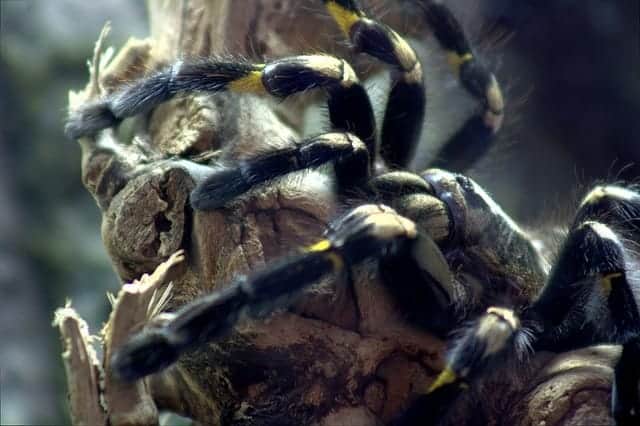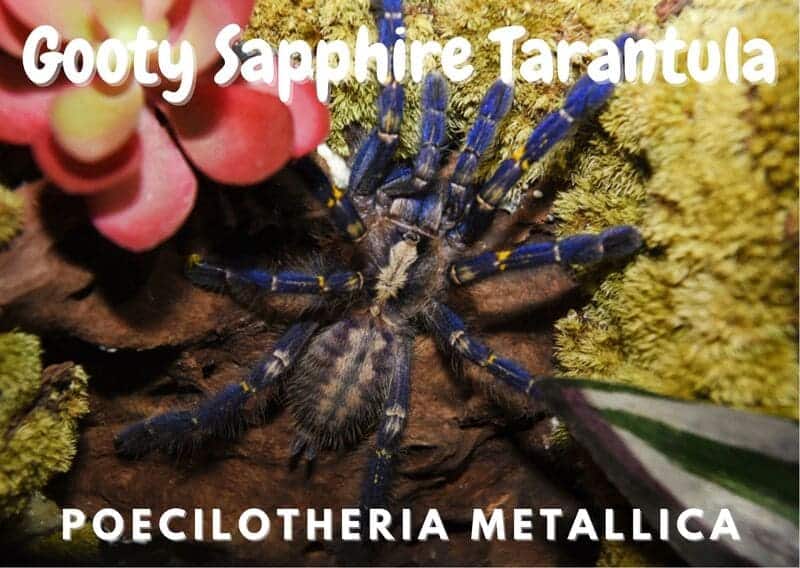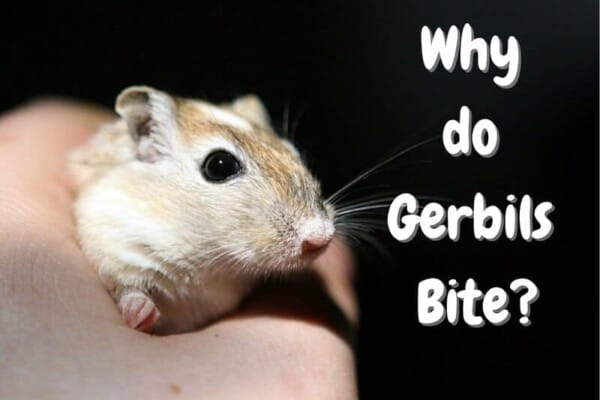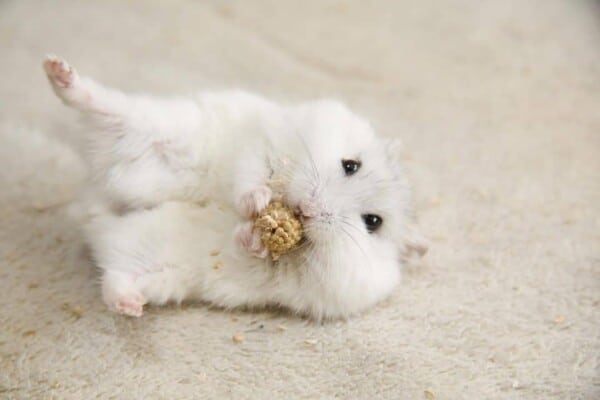The Gooty Sapphire Ornamental is one stunningly beautiful spider that originates from India. It is often the showcase of spider collectors and is praised for its delicate body patterns. They aren’t the friendliest of tarantulas but will mesmerize you nonetheless. See why owning a Gooty Sapphire Tarantula is meant for the experts.
Gooty Sapphire Tarantula Overview
| Scientific Name | Poecilotheria Metallica |
| Dwelling | Arboreal |
| Size | up to 8 inches |
| Lifespan | 4 years (male) / 12 years (female) |
| Food | crickets, grasshoppers, moths, flying insects, cockroaches, mealworms, pinky mice |
| Difficulty | Advanced |
Scientific Name
Poecilotheria Metallica- originally designated Poecilotheria Metallica Pocock (1899).
Characteristics of the Gooty Sapphire Tarantula
This arboreal bird spider originated from the Southeast portion of India and is categorized as Old World. It was rediscovered in 2001, within the decimated forests between Nandyal and Giddalur.

The Gooty Sapphire is distinct in its class for having a remarkable metallic blue color on its body and legs. The thorax and abdomen display characteristic ornamental designs as well. There can also be seen splashes of yellow and white thrown in likewise.
The Gooty has characteristic features seen more in the females while the males still stand up for having brilliant colors too. As rare as their colors are as a show spider, these colors serve as a warning as well.
Size
On average the body length of a female Gooty is 6cm with a leg span of 20cm. The female will mature to a length of 6 inches while the male is significantly smaller. Males on average reach 5cm body length and will have longer thinner legs than females. In comparison to other tarantula spiders, these are larger than most species tend to be.
Lifespan
The female is the clear winner between the two sexes and can live up to 15 years. On average most females will live more likely as many as 10-12 years in captivity. A male will not reach that age since mating usually allows them 3-4 years tops.
Difficulty of care
While they might look to be non-aggressive, these spiders are strictly for advanced spider enthusiasts. For many reasons, this species is notorious for being aggressive and tricky to care for.
Mostly they like to be left alone and when provoked can often bite. Outside their habitat, they can move very fast and can be difficult to catch.
Housing the Gooty Sapphire Tarantula
Since these arboreal spiders get rather large they need an enclosure that matches the size they will grow into. On average you must use the ratios of 1x1x2 for the leg span of your Gooty. This means if their leg span is 20 cm the enclosure needs to be 12″ x 12″x 18″. This would mean that 20cm converts to nearly 8 inches so doubling this is 16 inches. The extra two inches are a general buffer for their environment and decorations. You can use a smaller enclosure if they are young but later you will need to upgrade.
Adult tanks should be glass or plastic, however, keeping humidity levels constant will be better suited with glass.
Cleaning
The only cleaning that you might need to do with your blue ornamental enclosure is removing left-over insect husks. This species is known for putting its food bolus in the same spot. So cleaning will be a bit easier.
The substrate needs to be removed once a month on average. As long as there is no presence of bacterial growth it can be longer than a monthly cleaning. After any feeding, left-over live insects should always be removed as well.
Accessories
The Gooty Sapphire lives in trees, so you’ll need to reproduce a habitat similar to that. It will need some plants they can crawl up over and a bark hide that they can call home.
Some owners will try to reproduce a forest-like scene but less is more. Keep a simple set-up where your Gooty can climb into their hide on one corner or in their sling.
Humidity
The humidity should be a constant 70-80% but should allow ventilation, so bacteria won’t start to grow. India often has balmy weather which your Gooty will need. The addition of living plants and a semi-moist substrate will make up for the rest of the humid conditions.
Make sure there is a hygrometer to check for the optimal humid setting. Using a spray bottle can help to increase higher rates if it gets too dry.
Having a water bowl present might not be enough for adding the right humidity either. You can add a light mist on the inside of the enclosure to keep that level steady.
Since this is an advanced tarantula species, be sure to add a heating pad under the tank enclosure. This will help to make the humidity more naturally occurring on a low heat level.
Temperature and Lighting
An exterior lamp should be sufficient to simulate sunlight and added heat. Incandescent bulbs work best to reproduce sunny conditions for this spider. The temperature should be 78-82F and remain constant all year.
Also, make sure that you only use 12 hours of light in the day and no light for simulating night. This species is not very fond of light so even if you use the light, it might not be great for them. They will typically hide if the light is too harsh anyway.
Have a temperature strip that can monitor the inner temperature of the enclosure. You might even want to install upper lid vents to let excess heat escape. The heating pad will provide most of your heat, as a lamp will not always do the trick. Lighting is more of an aesthetic part of your Gooty enclosure.
Substrate
Having a taller enclosure is important and you will need to put a minimum of 4-5 inches of the substrate on the floor. This will allow the potted plant to rest firmly on the bottom of the tank. It will also help stabilize any bark exterior sling that you put inside also. Your spider does not burrow so the material used for the substrate can be very simple.
Using 25% coconut fiber, this all-natural material resists bacteria growth. Then add 25% peat moss mixed with 25% sphagnum moss and 25% vermiculite. Mix them all and it should be perfect for maintaining a bacteria-free substrate material.
Considering that the humidity is constant, the substrate will have an edge in keeping your spider healthier on that note. Unwanted things that can grow in soil, especially from insects that are introduced can carry bacteria or mites. The last thing that you want with this species is sickness or death.
Feeding habits of the Poecilotheria Metallica
The types of food that the Gooty Sapphire will enjoy most are crickets, grasshoppers, and moths. They especially enjoy flying insects and will readily hunt them at night. This is not the only food you can introduce since larger spiders can enjoy a pinky mouse as well. Selected cockroaches and mealworms can also be introduced.
For the smaller spiders, be sure to feed crickets that are appropriately sized for them to capture and eat. They will need nymphs and mealworms which are fine. as they grow bigger larger insects can be given.
How often does the Gooty Sapphire need feeding?
Try not to overfeed your Gooty, since they do grow fast. Little tarantula spiders will molt more often so feeding shouldn’t take place for a couple of days. However, the mature spiders will molt once a year and you need to wait up to 4-6 weeks before feeding them. Their fangs will not be hard enough. You may feed the adults weekly until they start to molt.
A female which molted in her 2-3rd year will need plenty of food when she is preparing to mate. A healthy-fed male and female will be best suited for mating after their molt because of this. It also ensures the mating process is unchallenged. Most experts believe this is because they have had enough to eat around that time.
Drink
Gooty tarantulas will need a small basin of water to drink from. In the substrate, you can dig out an area that has a shallow water dish. It won’t be uncommon that they will try to fill it with the substrate. So you will need to keep the water clean daily.
As long as they have clean water, they will not become dehydrated. This is especially so if they are getting ready for an annual molt.
Handling the Gooty Sapphire Tarantula
These are considered aggressive spiders despite numerous online videos showing otherwise. They can be spooked very easily and feel provoked enough to bite.
While they do not have dangerous venom, the bite itself is seriously painful. The bite wounds are similar to a wasp sting and can induce fever, sweating, and tremendous pain in that bitten area.
They are not recommended for handling and even professional breeders do not handle them for this reason. In nature their color is a warning to other animals, so owners should heed that message. All too often the Gooty Sapphire is likened to harmless easygoing tarantulas, but this is not so. First-time owners need to be very careful with this unpredictable species.
Common health problems affecting the Gooty Sapphire
As is the case for any tarantula, mites can present a problem that will affect them if there are too many mites swarming your spider. They can over-run the spider’s mouth and cause sickness and eventually death. This is usually when the substrate is not cleaned properly or mites are present on other insects that are fed to your spider. Be sure to make sure cockroaches or crickets are bred by a reliable dealer and don’t buy imported insects either.
Molting is one part of your spider’s life that allows them to grow larger. Their exoskeleton will prevent this so they need to starve themselves to exit that shell. At this time you might see them being lazier than usual. Not eating for weeks is another sign that may cause panic. There are even times when you will see they have flopped over and look like they are dead.
Do not attempt to flip them over, they will respond very defensively and retreat to a safer area to continue molting. What you can do is increase the humidity to aid their escape from their little prison. Once they emerge, they will be defenseless and need to let their new exoskeleton become hard. Depending on their size it can take days or several weeks.
Breeding the Gooty Sapphire Tarantula
These metallic blue spiders only mate once a year. It takes up to 2-3 years before the male and female can mate. After they have molted and their exoskeleton is dry enough they will start the mating process. The male will produce a sperm sack that he will carry with him. Females will wait for a suitor on the floor of the substrate.
During these periods both of them must be well-fed to reduce fighting. The male Gooty has no tibial hooks, so chances are a female can attack and kill him for mating attempts. It can take several attempts by a male but in the end, he can succeed and likely get away safely. After that females need to be fed more often.
Surprisingly the female will take her time laying eggs. It can take up to 4-6 months for her to start making a cocoon for the eggs. A healthy female can lay up to 100 eggs or more.
Most breeders will have problems just getting them to breed at all. After the female deposits eggs into the cocoon, they can be removed from the sack after 5 weeks. They will hatch soon after.
What to do with the spiderlings
If you are lucky enough to have hatching eggs, the spiderlings will be quite valuable. You can sell them off to private buyers or a professional for a total set price. Spiderlings sell up to 200 dollars in some US markets and are very rare to find at a cheap price.
Availability of the Gooty Sapphire Tarantula
It is true that the Gooty Sapphire tarantula is a very desirable species of spider but does come at a cost. The difficulty in breeding methods, and even simulating monsoon seasons after a molt are tough to reproduce. If you do find a dealer who sells Gooty spiders, they will be asking some outlandish prices too. Be sure to check around for a smaller spider that is genuine.
Most people have been sold baby Gootys only to find out they are common tarantulas. They don’t start to become metallic blue until they begin to mature. So buyers beware of possible Gooty scams.
Resources and further reading:
- Occurrence of Poecilotheria Metallica Pocock, 1899 from Seshachalam Hills, Eastern Ghats, Andhra Pradesh, India, Guptha, M. Bubesh; Rao, P. V. Chalapathi; Prasad, N. V. Sivaram
Contents
- Gooty Sapphire Tarantula Overview
- Scientific Name
- Characteristics of the Gooty Sapphire Tarantula
- Housing the Gooty Sapphire Tarantula
- Feeding habits of the Poecilotheria Metallica
- Handling the Gooty Sapphire Tarantula
- Common health problems affecting the Gooty Sapphire
- Breeding the Gooty Sapphire Tarantula
- Availability of the Gooty Sapphire Tarantula













